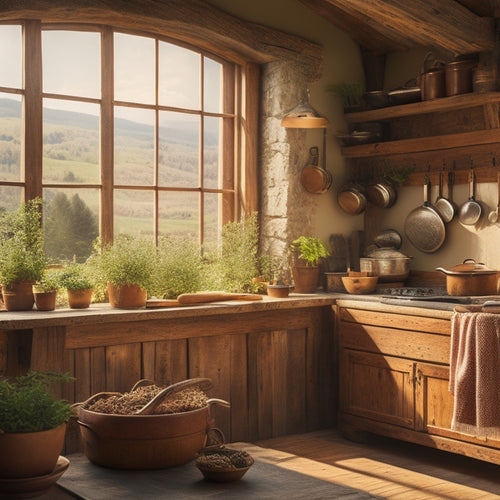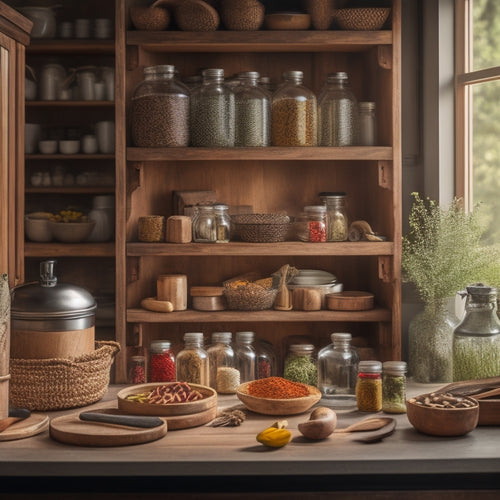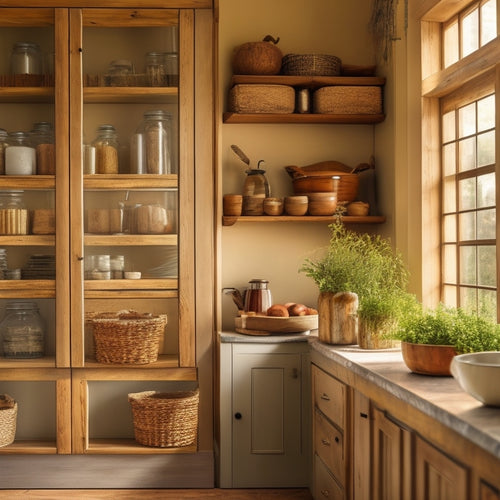
DIY Project: Stylish Kitchen Shelf Creation Guide
Share
To create a stylish kitchen shelf that exudes both form and function, start by gathering essential materials, including moisture-resistant wood panels, a table saw, level, screws, and power drill. Guarantee precise measurements by cutting wood panels with a table saw, and secure vertical pieces with screws and a power drill. Optimize shelf dimensions to fit your kitchen layout, considering adjustable shelves and built-in wine racks. Balance aesthetics with practicality, choosing durable materials and finishes for ease of cleaning. By focusing on functionality and durability, you'll be on your way to crafting a stylish kitchen shelf that becomes the focal point of your kitchen.
Key Takeaways
• Prioritize durable materials and finishes for your kitchen shelf to ensure ease of cleaning and longevity.
• Measure the space accurately, leaving a 1/2 inch gap at the top, and cut wood panels to size using a table saw.
• Opt for adjustable shelves or built-in wine racks to enhance usability and maximize storage space.
• Balance aesthetics with practicality by choosing a paint color that complements the kitchen's aesthetic and incorporating organizing tips.
• Customize your shelf with space-saving solutions like baskets or dividers to create a functional focal point that streamlines the cooking routine.
Gathering Essential Materials
Stock up on the necessary components by collecting wood panels from Ikea, a table saw, level, screws, and power drill. All of these items will form the foundation of your stylish kitchen shelf creation.
When choosing materials, prioritize quality and durability to guarantee a sturdy structure. Opt for wood panels that are resistant to moisture and scratches.
Regarding tool safety, always wear protective gear, such as safety glasses and gloves, when operating power tools like the table saw and power drill. Additionally, maintain a stable work surface and keep a safe distance from the tools to avoid accidents.
Building Your Kitchen Shelf
Measure the height of the space where you plan to install your kitchen shelf, taking care to leave a 1/2 inch gap at the top to accommodate the fridge and guarantee a seamless fit.
Cut the wood panels to size using a table saw, ensuring precise measurements for a snug fit.
Install the vertical pieces first, securing them with screws and a power drill. Then, place the horizontal shelves, carefully aligning them with the vertical supports.
Consider customizing options, such as adding space-saving solutions like baskets or dividers, to maximize storage.
Select a paint color that complements your kitchen's aesthetic, and don't forget to incorporate organizing tips, like grouping similar items together, to maintain a clutter-free space.
Designing With Functionality
A well-crafted kitchen shelf seamlessly integrates form and function, providing a stylish storage solution that complements your kitchen's aesthetic while keeping essentials within easy reach.
When designing with functionality in mind, consider maximizing space by optimizing the shelf's dimensions to fit your kitchen's unique layout. Customizing options, such as adjustable shelves or built-in wine racks, can also enhance the shelf's usability.
Additionally, consider the shelf's material and finish to guarantee durability and ease of cleaning. By balancing aesthetics with practicality, your kitchen shelf can become a functional focal point that streamlines your cooking routine.
With thoughtful design, you can create a stylish and functional storage solution that elevates your kitchen's overall functionality and visual appeal.
Frequently Asked Questions
Can I Use Other Types of Wood Besides Ikea Panels?
When considering alternative wood options, reclaimed wood and plywood shelves can be viable substitutes, offering unique textures and character. However, guarantee proper treatment and safety precautions to avoid any potential hazards or structural compromise.
How Do I Clean and Maintain the Kitchen Shelf?
To maintain your kitchen shelf, regularly dust with a soft cloth and clean with a mild detergent and water. For wood panels, avoid harsh chemicals and abrasive materials that can damage the shelf material.
Are There Any Load Capacity Restrictions for the Shelves?
When designing a kitchen shelf, consider load capacity restrictions to guarantee safety. The weight limit depends on material options and installation methods, with wood panels typically supporting 20-30 pounds per shelf, while metal shelves can hold up to 50 pounds.
Can I Customize the Shelf Design for a Corner Space?
When designing a corner shelf, consider angled or curved wood pieces to maximize space. Implement space-saving solutions like tiered shelving or rotating carousels to optimize corner storage, ensuring a safe and functional design that enhances kitchen workflow.
Do I Need to Add a Finish or Sealant to the Wood?
To protect the wood and enhance shelf aesthetics, consider applying a finish or sealant to prevent warping and staining, ensuring easy maintenance and a beautiful, long-lasting installation that complements your kitchen style.
Related Posts
-

Rustic Hanging Racks for Country-Style Kitchens
Rustic hanging racks are a game changer for your country-style kitchen, blending functionality with charm. They maxim...
-

Revolving Cabinet Organizer Lazy Susan
A revolving cabinet organizer like a Lazy Susan is a transformative solution for your kitchen. It maximizes space and...
-

Freestanding Pantry Units for Farmhouse Kitchen Style
Freestanding pantry units perfectly blend beauty and function in your farmhouse kitchen. They maximize storage while ...


